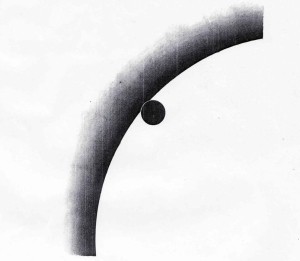
To the naked eye, Venus is one of the most easily identified planets. It’s the bright evening (and morning) star that you often see plopped in the sky blazing brilliantly next to the moon. Recently, as Venus has made her way around the sun, the planet has been lost in the star’s fiery glare and become invisible to the human eye. But tonight, Venus is about to do some historical celestial footwork, and will appear to you in a way that you’ll never again see in your lifetime.
Venus – as usual – is surely and steadily traveling her regular orbit around the sun, which happens every 19 months. But this year, on this night, Venus will be the center of attention as its orbit aligns with Earth’s orbit around the sun. Just like the old song by The Police, on June 5 (or June 6, depending on where you are on the globe), there will be “a little black spot on the sun,” and that spot will be Venus as she glides across the face of the sun.
The orbit of Venus is inclined toward the Earth’s orbit by about three degrees, explained Mark Breen, senior meteorologist and planetarium director at the Fairbanks Museum and Planetarium in St. Johnsbury, Vermont. Those few degrees are just enough so that when Venus makes its orbit every 1.6 years, it’s just a bit above or below the sun as it passes between the Earth and Sun, so we can’t see it. This year, however, Venus’ orbit will be level with that of the Earth’s for about six-and-a-half hours. For those of us in Vermont and New Hampshire, the transit will be visible tonight beginning at sunset (if the clouds allow).
Some might recall that there was a transit of Venus in 2004, which may make one wonder, “If the last one was just eight years ago, what’s the big to-do?” It’s true the previous transit was less than a decade ago, but the one before that was in 1882, with one occurring eight years prior to that in 1874. Preceding that pair of transits, Venus made its transit in 1761 and 1769.
Venus’ transits occur in pairs eight years apart, and then not again for 121.5 years and then 105.5 years. The first predicted transit was the one that occurred in 1631 by German astronomer Johannes Kepler. Eight years later, English astronomer Jeremiah Horrocks was the first person to observe a Venus transit, and the data he collected allowed him to make attempts atcalculating Venus’ size, as well as the distance between the Earth and sun.
It became the goal of scientists awaiting the 1760s transits to “measure the size of the solar system,” based on these transit observations, Breen said. It had become clear after the transits of the 1600s that figuresfrom the transit taken from places around the globe might allow them to approximate the distance of Earth from the sun, Breen explained.
The international community of the mid-1700s was rife with tension, but astronomers managed to come together in the name of science. To be sure, “this was not some wonderful international cooperation,” Breen said, but rather countries determined to make their mark in history by providing their own astronomers to observe the celestial event and collaborate data. Chronometers, sextants, and telescopes all came into use. The black drop effect, too, had – and still has – its place in helping provide information about our solar system.
As Venus moves across the face of the sun, it appears as a black dot. When the black dot nears the edge of the sun, it appears to lose its round shape and smear into the edge of the sun. It is merely an optical illusion. (The same thing happens if you hold your pointer finger and thumb in front of you at arm’s length, then slowly move them together as if trying pinch something. Your finger and thumb appear to be touching each other before they actually are.)
This illusion made it impossiblefor early observers to calculate exactly when Venus crossed in front of the sun and out of it. Without this accuracy, eighteenth-century astronomers still could not accurately assess the distance between the Earth and sun.
Today, that black dot still holds significance.
“During the most recent transit in 2004, scientists were able to measure a very slight change in the brightness of the sun,” Breen said. “The black dot of Venus going in front of sun – reducing the light of sun – is important because it’s one of the ways scientists can discover other planets going around other stars.” In other words, how much of the sun’s light is diminished by Venus’ passage across it gives scientists a number to work with in determining if other planets are orbiting other stars based on how their light dims. “That’s one of the next frontiers in astronomy,” said Breen.
The next transits of Venus will occur in December 2117 and 2125.
To get the scoop on exactly when, where, and how (do not look directly into the sun) you can observe Venus’ transit, go to transitofvenus.org. The Fairbanks Museum and Planetarium will host a viewing tonight from 5-8 p.m.,on the grounds of Northwestern Medical Center in St. Albans, Vermont. Click here to learn more.

